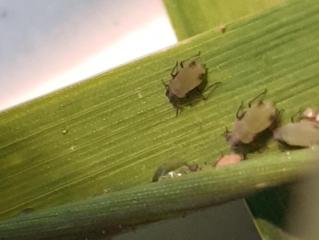Cereal aphids
- Woorree (Geraldton)
Technical officer Anne Smith (DPIRD) has found corn aphids in a barley trial at Woorree (near Geraldton). The barley was at the stem elongation growth stage.
The two main cereal aphids in WA are corn aphids and oat aphids.
Corn aphids are light green to dark olive green with darker patches at the base of the tube –like projections (siphuncles) on either side at the rear of the body.
Corn aphid colonies are often difficult to detect because they usually develop within the furled leaves of tillers any time from seedling to head emergence.
Oat aphids are the most abundant species of cereal aphids and vary from mottled yellow-green through olive-green and dusky brown, to a blackish green and are characterised by a reddish patch on the tip of the abdomen.
Oat aphid colonies develop on the outside of tillers from the base upwards on stems, nodes and backs of mature leaves, starting any time between seedling stage and grain filling.
Cereal aphid adults and nymphs suck plant sap with large populations limiting grain yield and size, especially with winter and spring infestations. Cereal aphids also spread barley yellow dwarf virus that reduces cereal yield.
It is also important that growers and consultants continue to monitor WA cereal crops for the Russian wheat aphid (RWA). This pest has not been found in WA. In addition to feeding damage it can inject toxins into cereal plants further stunting them and reducing yields. For more information on RWA refer to the department’s Diagnosing russian wheat aphid and Biosecurity alert - Russian wheat aphid pages. For more tips on how to identify RWA view cesar’s Russian wheat aphid identification video.
Growers and consultants can use the PestFax Reporter app to request or confirm identification of aphids found in crops.
For a list of insecticides registered for use on aphids see the department’s 2020 Winter Spring Insecticide Guide.
For more information on cereal aphids refer the department’s Diagnosing cereal aphids page and 2017 Protecting WA Crops Issue 3 newsletter Aphids – WA’s insect problem children.
For more information on aphids contact Svetlana Micic, Research scientist, Albany on +61 (0)8 9892 8591 or Alan Lord, Technical officer, South Perth on +61 (0)8 9368 3758.
Article author: Cindy Webster (DPIRD Narrogin).

